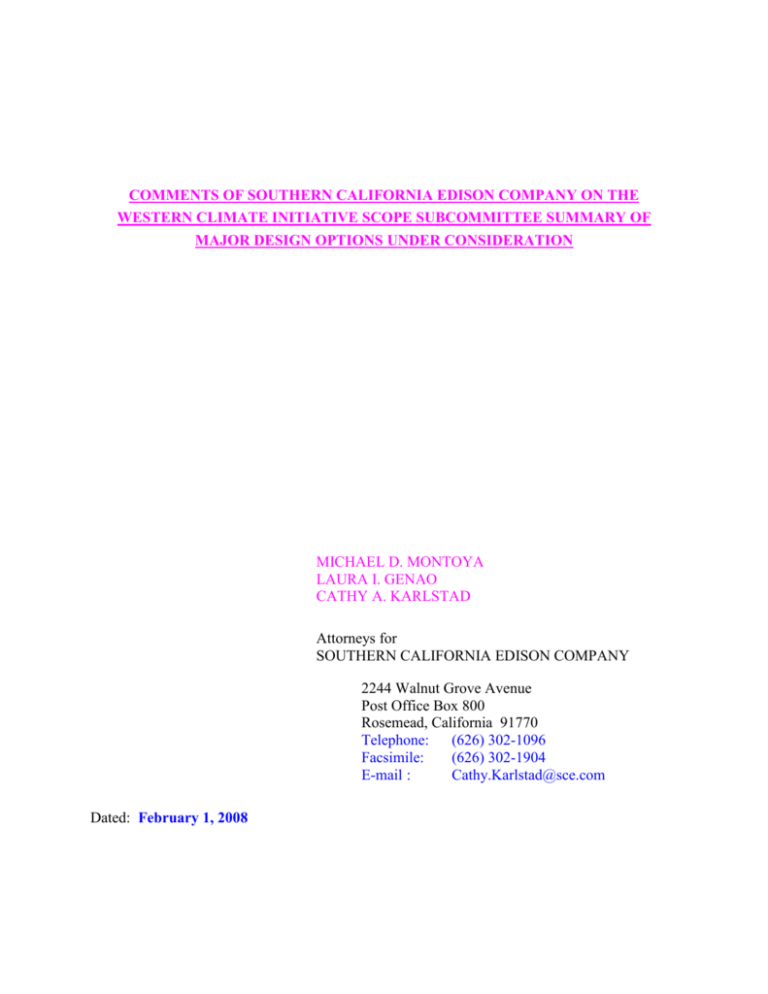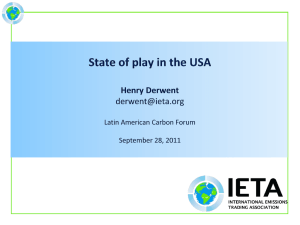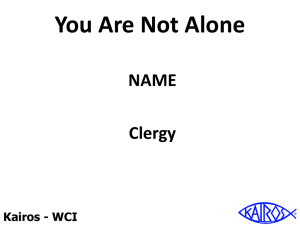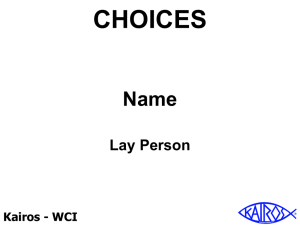comments of southern california edison company on the western
advertisement

COMMENTS OF SOUTHERN CALIFORNIA EDISON COMPANY ON THE WESTERN CLIMATE INITIATIVE SCOPE SUBCOMMITTEE SUMMARY OF MAJOR DESIGN OPTIONS UNDER CONSIDERATION MICHAEL D. MONTOYA LAURA I. GENAO CATHY A. KARLSTAD Attorneys for SOUTHERN CALIFORNIA EDISON COMPANY 2244 Walnut Grove Avenue Post Office Box 800 Rosemead, California 91770 Telephone: (626) 302-1096 Facsimile: (626) 302-1904 E-mail : Cathy.Karlstad@sce.com Dated: February 1, 2008 Southern California Edison Company (SCE) appreciates the opportunity to provide comments on the Western Climate Initiative (WCI) Scope Subcommittee Summary of Major Design Options Under Consideration (WCI Design Options Paper). The WCI Design Options Paper states that the mission of the Scope Subcommittee is to recommend the scope of a proposed greenhouse gas (GHG) emissions cap-and-trade program, defining: (1) the sectors that fall under the cap-and-trade program; (2) the emissions sources that fall under the cap-and-trade program; (3) the GHGs that fall under the cap-and-trade program; and (4) the point(s) of regulation where the cap-and-trade program would be enforced. The inclusion of the electricity sector in the proposed cap-and-trade program is being separately assessed by the WCI Electricity Subcommittee. SCE has provided comments on the WCI Electricity Subcommittee’s request for stakeholder input on the best overall approach and point of regulation for the electricity sector.1 In addition to SCE’s previously filed comments regarding the electricity sector, SCE proposes the following policies and principles for designing a WCI cap-and-trade program. A. The WCI Cap-And-Trade Program Should Be Able To Easily Integrate With A Future Federal Program While SCE supports the efforts of the WCI to broaden and coordinate GHG reduction efforts across the western states, a federal program is ultimately the best way to reduce GHG emissions. Accordingly, the design and implementation of any WCI cap-and-trade program should be undertaken with the goal of creating a WCI program that will be able to seamlessly integrate with a future federal program. There are many benefits of a federal cap-and-trade program that make a federal program preferable to a regional program. Among other things, a federal program will largely eliminate many of the leakage issues raised in the WCI Design Options Paper. SCE believes that leakage 1 See Comments of Southern California Edison Company on the Western Climate Initiative Electricity Subcommittee Update on Subcommittee Activities and Request for Stakeholder Input (filed with the Electricity Subcommittee on Jan. 22, 2008). -2- is a serious problem that will undermine the effectiveness of a regional cap-and-trade program. By expanding the boundaries of a cap-and-trade program to the national level, entities subject to the program will have few options for shuffling of emissions and compromising the environmental integrity of the program. Moreover, because a cap-and-trade program with a larger geographic reach will provide regulated entities with a greater selection of lower cost options to reduce emissions, thus reducing the overall costs of GHG emissions reductions for consumers, a federal program will lower the costs of compliance for consumers relative to a regional program that only covers the WCI partners. Given the current status of proposed federal legislation regarding GHG emissions and the growing national and international concern over global warming, it seems likely that a federal GHG program will be adopted within the next few years. Designing a WCI program that will be able to easily integrate with a future federal program will minimize sunk costs for WCI partners and give the WCI a better opportunity to influence the direction of a federal program. Unlike other air quality challenges, climate change is truly a global issue. No matter where GHGs are emitted, reduced, or sequestered, GHGs mix uniformly in the atmosphere. A robust GHG emissions market can be assured by including as many industry sectors and participants as possible and creating linkages to other existing and emerging programs (e.g., the Regional Greenhouse Gas Initiative (RGGI) and the European Union Emission Trading Scheme (EU ETS)), and, ultimately, a federal program or an international program including the United States. A WCI cap-and-trade program should be designed and implemented in a manner that will accomplish this linkage. B. The WCI Cap-And-Trade Program Should Include A Broad Multi-Sector Market The WCI cap-and-trade program should strive to incorporate as many emissions sectors as possible. The two largest sources of emissions – the electricity and transportation sectors – must be included in any cap-and-trade program. The WCI Design Options Paper notes that the transportation sector is the largest or second largest source of GHG emissions for each of the -3- WCI partners. Despite this fact, however, many of the major scope options under consideration by the WCI exclude the transportation sector, while most include the electricity sector. SCE is concerned by the transportation sector’s exclusion from many of the scope options being considered by the WCI. Given the significance of the transportation sector’s GHG emissions for all of the WCI partners, exclusion of the transportation sector from a WCI cap-and-trade program will significantly undermine the effectiveness of the program. Substantial GHG reductions cannot be achieved by ignoring one of the largest emitting sectors. Moreover, the efficiency of a WCI GHG market will be significantly undermined if the transportation sector is not included. Any WCI cap-and-trade program should include the transportation sector, as well as broadly covering other emitting sectors. The benefits of a comprehensive multi-sector market include: Minimizing costs to customers; Allowing for a broad range of cost-effective compliance options; Establishing a broad, liquid, and transparent market that includes linkages to other domestic and international programs;2 and Providing for a reasonable degree of regulatory certainty to facilitate necessary investments. C. Upstream Point Of Regulation Is Preferred Over Downstream Point Of Regulation When designing a cap-and-trade program, the WCI should regulate at an upstream point of regulation rather than a downstream point of regulation whenever possible. An upstream point of regulation is preferable because it internalizes the costs of emissions and sends an effective price signal to all downstream users, resulting in investments in low-GHG technologies. In addition, an upstream point of regulation is administratively simple, provides for the most 2 “A program that covers higher percentages of GHG emissions will have a larger and more diverse allowance market, and therefore will tend to have less volatile prices and a more liquid allowance market.” Dr. Andrew G. Keeler, John Glenn School of Public Affairs, The Ohio State University, National Regulatory Research Institute, State Commission Electricity Regulation Under a Federal Greenhouse Gas Cap-and-Trade Policy at 52 (Jan. 2008) (available at http://nrri2.org/index.php?option=com_content&task=view&id=57&Itemid=48). -4- accurate accounting of GHG emissions, and minimizes leakage of GHG emissions. For these and other reasons, SCE advocates that the electricity sector be regulated under a source-based or first seller approach as explained in SCE’s prior comments to the Electricity Subcommittee. As Dr. Andrew G. Keller explained in this paper, “State Commission Electricity Regulation Under a Federal Greenhouse Gas Cap-and-Trade Policy:” Upstream administration is fully compatible with an economy-wide system and also makes allowance sale behavior transparent to commission regulation. It has the advantage of low administration costs as well. The system can be administered at a fairly limited number of coal mines and processing plants, natural gas pipelines, and oil refineries and can cover the overwhelming majority of fossil fuel combustion.3 D. The WCI’s Program Should Include Flexible Compliance Mechanisms To Increase Program Effectiveness And Reduce Costs The WCI’s program should include flexible compliance mechanisms which will allow regulated entities to better manage their emissions reduction activities, while simultaneously providing a form of cost control. These flexible compliance mechanisms should include offsets, cost control measures, banking of emissions allowances, borrowing of emissions allowances, and multi-year compliance periods. This last element is critically important to the electricity sector, where weather and precipitation variability have a significant impact on year-to-year emissions. 1. Offsets Should Be Allowed Quality offsets without geographic restriction present the WCI with an important tool to reduce GHG emissions at a lower cost. Offsets provide regulated entities with increased compliance flexibility, and improve cost-effectiveness by allowing regulated entities to find the most cost-effective opportunities for reducing their emissions. Offsets should be allowed from a range of domestic and international sources. To ensure the environmental integrity of the offsets 3 Id. at 53. -5- and that the price of GHGs is being adequately reflected, offsets allowed for use in the WCI program should be environmentally additional, verifiable, permanent, and enforceable. 2. Cost Control Measures (e.g., Safety Valve) Should Be Included Cost control measures provide regulated entities with greater confidence that their compliance costs, and those of their customers, will be limited. The WCI program should provide program adjustments if unanticipated and sustained market impacts occur. Specific evaluation criteria for assessing unanticipated market impacts should be established prior to program implementation to ensure the integrity of the emissions cap over a multi-year period and preserve the market’s effectiveness in driving reductions, investment, and innovation. In addition, cost control measures, such as a cost safety valve and a strategic allowance reserve which could be triggered under pre-established criteria, should be included to mitigate unanticipated market failures or dysfunctions and prevent excessive or volatile compliance costs. 3. Banking and Borrowing of Allowances Should Be Allowed The banking and borrowing of allowances will increase program compliance, while maintaining environmental integrity. The option to bank and borrow allowances provides regulated entities greater freedom to meet their compliance requirements, especially when faced with factors that are beyond their control. For example, there are many entities that will have emissions that will vary based on annual fluctuations in the climate, the economy, and commodity pricing. 4. The WCI Should Establish a Clear and Gradual Emissions Reduction Trajectory The WCI should take a clear and gradual approach to meeting emissions reductions targets in order to avoid costly and uneconomic decisions and to provide for a longer term price signal to encourage appropriate investments and allow for long-term capital investments. The -6- emissions reduction trajectory should be gradual for the early years, providing industry time to adjust and innovate. Emissions reductions should then increase in the later years. E. Conclusion SCE appreciates the opportunity to provide these comments and urges the WCI to consider the principles raised herein. SCE supports a WCI cap-and-trade program and looks forward to continuing to work with WCI in its assessment and implementation of the program. Respectfully submitted, MICHAEL D. MONTOYA LAURA I. GENAO CATHY A. KARLSTAD /s/ Cathy A. Karlstad By: Cathy A. Karlstad Attorneys for SOUTHERN CALIFORNIA EDISON COMPANY 2244 Walnut Grove Avenue Post Office Box 800 Rosemead, California 91770 Telephone: (626) 302-1096 Facsimile: (626) 302-1904 E-mail: Cathy.Karlstad@sce.com February 1, 2008 -7-









